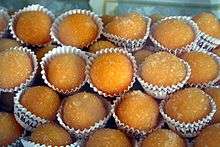Yemas de Santa Teresa
Yemas de Santa Teresa (en: Yolks of Saint Teresa) or Yemas de Ávila (en: Yolks of Ávila) is a pastry that is identified with the Spanish province of Ávila. Its fame has spread across the country and they can be bought throughout Spain but typically they are a souvenir connected with the city of Ávila.
 | |
| Type | Pastry |
|---|---|
| Place of origin | Spain |
| Region or state | Ávila |
| Main ingredients | Egg yolks, syrup, lemon juice, cinnamon |

They are very popular for their distinctive look: small orange balls served in a white confectionery paper and are made to honor Teresa of Ávila.
A possible derivative known as yema is also a popular delicacy in the Philippines, a former colony of Spain. However, they are commonly made as small pyramids or balls and sold as confectioneries rather than pastries.[1]
History
The origin of the pastry is uncertain but there are several opinions where it comes from. One theory assumes that it was a pastry shop in the Medieval Ages in Andalusia called "Flor de Castilla" that first sold a pastry under the name "Yemas de Santa Teresa". Don Isabelo Sánchez, founder of the pastry shop "La Dulce Aviles" (nowadays known as "Flor de Castilla") in Ávila commercialized the pastry in 1860 under the name "Yemas de Santa Teresa". The success of the dish was great and other pastry chefs in Ávila soon started to sell similar pastries which they called "Yemas de Ávila". Another theory credits the monks of the convent of Teresa of Ávila with the invention of the dish. With the beginning of the 21st century the market for "Yemas de Ávila" expanded and they are now on demand in North America. Therefore, a new packaging system was developed to improve the preservation and make them survive the shipping to America.
Characteristics
This pastry is made exclusively with egg yolks which are stirred in copper bowls. Meanwhile, syrup is cooked with lemon juice and cinnamon to reduce it until it is a dense mixture. The consistency can be proven by dipping a spoon into the syrup and is right when the sticky liquid keeps connected with the spoon by a thin thread.
As soon as the syrup reduction is gooey enough it is mixed with the egg yolks and stirred with them at a low heat. The pastry dough is left to cool and is then moulded into the special kind of balls with a few centimetres diameter and put into the tartlet papers.
See also
References
- Serna Estrella (5 February 2014). "Yema: The Origins of a Classic Filipino Candy". Pepper.ph. Retrieved 3 April 2018.